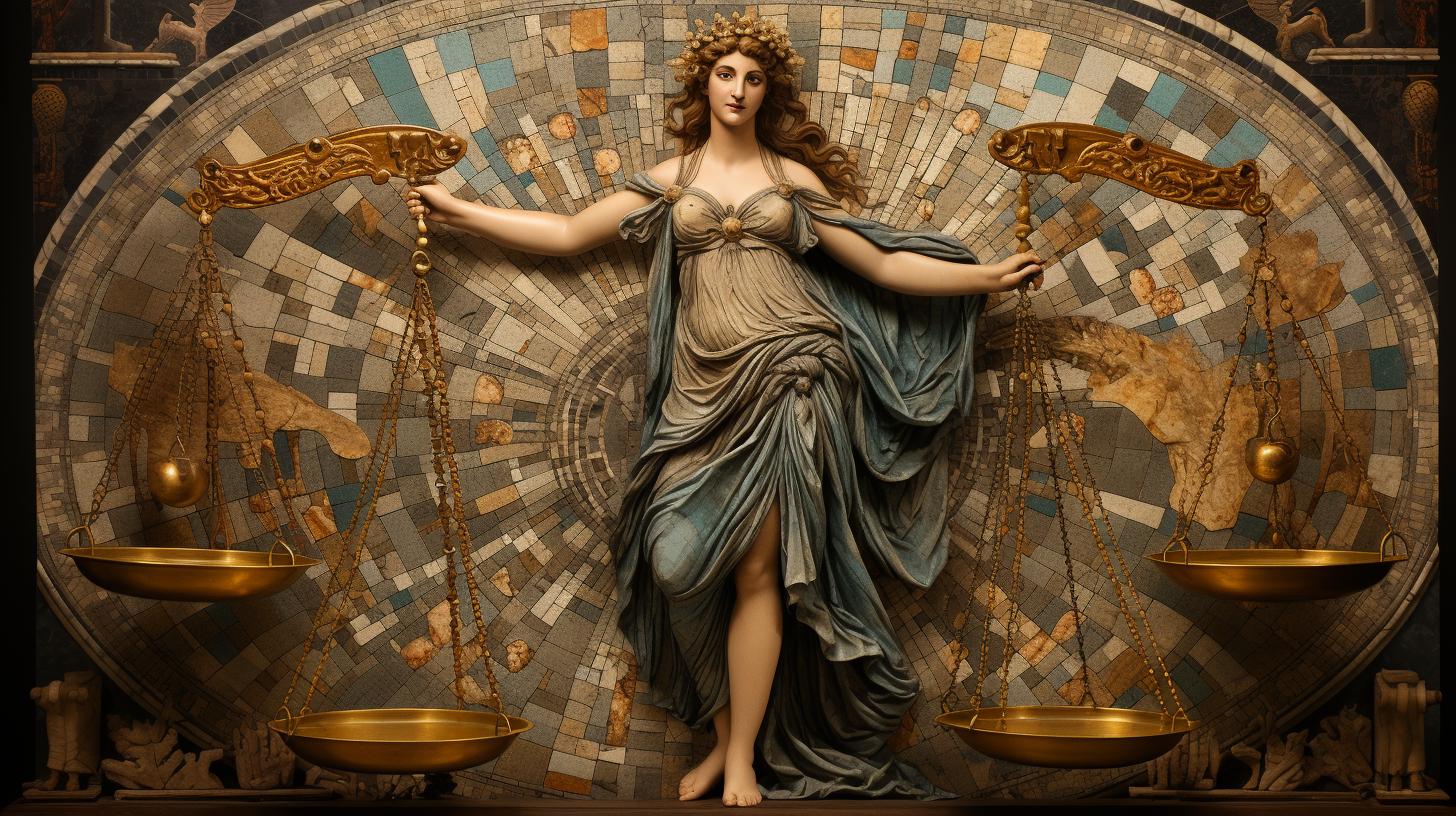Roman God of Peace: Unveiling the Legacy of Pax in Ancient Roman Empire

Pax, the Roman goddess of peace, played a significant role in ancient Rome. Believed to be the daughter of Jupiter and the goddess Justitia, Pax became widely worshipped during the reign of Augustus.
Her iconic symbols included an olive branch, a caduceus, a cornucopia, a sheaf of corn, and a scepter. The era of Pax Augusta, also known as Pax Romana, saw peace becoming synonymous with Augustus and his rule.
However, as the Roman Empire evolved and Christianity gained prominence, the perception of peace transformed, leading to the decline of Pax’s worship.
History of Pax in Ancient Rome
Pax, the Roman goddess of peace, has a rich history intertwined with the ancient city of Rome. Understanding the origins and mythological background, association with prominent deities, and its popularization during the reign of Augustus provides illuminating insights into the significance of Pax in Roman society.
Origins and Mythological Background
The origins of Pax can be traced back to Roman mythology, where she is believed to be the daughter of Juptier, the king of the gods, and Justitia, the goddess of justice.
As a divine entity, Pax embodies the essence of peace and harmony, promoting stability and tranquility within Roman society.
Association with Jupiter and Justitia
Pax’s association with Jupiter and Justitia emphasizes her divine lineage and the importance of peace within the structure of Roman governance. With Jupiter representing supreme authority and Justitia symbolizing justice and fairness, Pax is positioned as a mediator and a catalyst for maintaining peace in the realm of mortals.
Popularization during the Reign of Augustus
During the reign of Augustus, Pax experienced a surge in popularity and reverence. Augustus, the first emperor of Rome, recognized the significance of peace as a stabilizing force for the empire.
He ordered the construction of the Ara Pacis, an altar dedicated to Pax, as a testament to the importance of peace in Roman society.
Augustus’ promotion of Pax extended beyond architectural endeavors. He actively fostered a climate of peace, which became synonymous with his rule, and propagated the concept of Pax Romana. This era saw a remarkable period of peace and stability across the Roman Empire, showcasing the profound influence of Pax and Augustus.
Symbols and Attributes of Pax
Pax, the Roman goddess of peace, is commonly depicted with various symbols and attributes that represent her significance and role in Roman society.
Representation with Olive Branch and Caduceus
One of the most recognizable symbols associated with Pax is the olive branch. The olive branch has long been a symbol of peace and harmony in many cultures, and it represents Pax’s role in bringing tranquility to the Roman Empire.
Additionally, Pax is often depicted carrying a caduceus, which is a staff intertwined with two serpents and topped with wings. The caduceus symbolizes her authority and ability to bring balance and order.
Significance of Cornucopia, Spiga de Maíz, and Cetro
Another attribute associated with Pax is the cornucopia, also known as the horn of plenty. The cornucopia symbolizes abundance and prosperity, reflecting the idea that peace brings about prosperity in society.
Additionally, Pax is often depicted holding a sheaf of corn, representing the bountiful harvest that comes with peace and stability. Furthermore, Pax is shown holding a cetro, which signifies her power and dominion over peace.
In Roman art and iconography, these symbols and attributes were used to visually represent Pax and emphasize her role as the goddess of peace. They served as reminders of the importance of maintaining harmony and tranquility within the Roman Empire.
Pax Romana: Augustus and the Era of Peace
The Pax Romana, meaning “Roman Peace,” was an era characterized by stability and prosperity throughout the Roman Empire. Under the leadership of Augustus, Pax Augusta became synonymous with a period of relative tranquility and order.
This section delves into the significance of Pax Romana and its association with Augustus, along with the architectural symbols that commemorated this era of peace.
Pax Augusta: Peace Synonymous with Augustus
During the reign of Augustus, the concept of peace became deeply intertwined with his leadership. Augustus emphasized the restoration and maintenance of peace throughout the empire, both internally and externally. By fostering stability, he aimed to promote prosperity and cultural development.
The phrase “Pax Augusta” emerged as a way to describe this peaceful era directly linked to the rule of Augustus.
The Ara Pacis and Vespasian’s Temple for Pax
A remarkable testament to the significance of Pax in Roman society was the construction of the Ara Pacis, an altar dedicated to peace. Commissioned by Augustus himself, the Ara Pacis represented the sacred space where offerings were made to honor Pax.
Additionally, the temple dedicated to Pax built by Emperor Vespasian further exemplified the importance placed on the goddess of peace.
Influence of Pax Romana on Roman Society
The era of Pax Romana had a profound impact on Roman society, extending beyond concepts of peace. It brought about a period of stability and economic prosperity, fostering trade, commerce, and the exchange of ideas.
The empire experienced significant advancements in architecture, literature, and the arts during this time. Pax Romana symbolized the pinnacle of Roman power and civilization, showcasing the achievements and cultural contributions of the empire.
The peace enforced by Augustus and the subsequent continuity of Pax Romana influenced the mentality and behavior of Roman citizens. Stability within the empire fostered a sense of security and allowed individuals to focus on personal growth and intellectual pursuits.
It paved the way for the flourishing of Roman civilization, leaving a lasting legacy that would shape historiography and cultural perception for centuries to come.
Decline and Transformation of Pax
The concept and perception of peace in Roman society underwent a significant change over time, leading to the decline and transformation of Pax. This section explores the factors that contributed to this shift, including the changing perception of peace and the arrival of Christianity.
Changing Perception of Peace in Roman Society
The notion of peace evolved as the Roman Empire expanded and encountered various cultures and traditions. The initial understanding of peace, embodied by Pax, was closely associated with the absence of conflict, stability, and order within the empire.
However, as the empire grew and faced internal challenges, the concept of peace started to emphasize more on imperial control and dominance. Peace became synonymous with the submission of conquered territories and the suppression of dissent.
Furthermore, societal changes and ideological transformations caused a shift in how peace was perceived. The expanding empire’s need for resources and constant military expansion led to widespread exploitation and inequality, undermining the idealized notion of peace.
The social unrest, economic disparity, and political corruption eroded the faith in the peaceful nature of the Roman Empire.
Arrival of Christianity and Shift in Religious Beliefs
The introduction and subsequent spread of Christianity had a profound impact on the perception of peace in Roman society. As Christianity gained momentum, it presented a new understanding of peace focused on spiritual salvation, love, and reconciliation.
The teachings of Christ emphasized peace as an inner state of being, as well as harmony and goodwill towards others.
This shift in religious beliefs challenged the traditional Roman worship of Pax and led to its gradual decline. Christianity provided an alternative framework for pursuing peace, one that emphasized personal transformation, forgiveness, and compassion.
As more Romans embraced Christianity, the worship of Pax waned, and the goddess gradually lost her significance as a symbol of peace.
- Christianity introduced a transformative understanding of peace rooted in spiritual salvation and compassion.
- The teachings of Christ emphasized inner peace and harmony with others.
- As Christianity gained popularity, the worship of Pax diminished in Roman society.
- Christianity offered an alternative framework for pursuing peace, challenging the traditional Roman concept.
In conclusion, the decline and transformation of Pax in Roman society were influenced by the changing perception of peace and the arrival of Christianity.
The evolving understanding of peace, marked by inequalities and control, led to a shift away from the traditional worship of Pax. Christianity, with its emphasis on inner peace and love for others, provided a new paradigm for pursuing peace that gradually replaced the significance of Pax in Roman culture and belief systems.
Legacy of Pax in Roman History and Culture
The legacy of Pax in Roman history and culture is profound, influencing various aspects of the Roman Empire. From its impact on governance to its significance in religion, worship, and mythology, Pax left an indelible mark on the civilization.
Impact on Roman Empire and Governance
Pax, the Roman goddess of peace, played a crucial role in shaping the Roman Empire and its governance. During the Pax Romana, the imperial administration under Augustus focused on maintaining peace and stability throughout the vast territories.
This era of relative tranquility allowed the empire to flourish economically, culturally, and politically. Pax became synonymous with the prosperity and order established by Augustus, reflecting his vision for a successful and harmonious Roman Empire.
Pax in Religion, Worship, and Mythology
As a goddess, Pax was widely revered and worshipped in Roman society. Her association with the concept of peace made her a central figure in religious practices and ceremonies. Altars, temples, and statues were dedicated to her honor, with offerings made by devotees seeking peace and prosperity.
Pax’s iconography, including the olive branch, caduceus, cornucopia, sheaf of corn, and scepter, symbolized her benevolence and nurturing nature. The Romans believed that honoring Pax would bring tranquility not only to their personal lives but also to the entire empire.
Comparisons with Greek Goddess Eirene
Pax shares similarities with the Greek goddess Eirene, who is also associated with peace. Eirene, depicted as a young woman holding an olive branch, represents harmony and cessation of hostilities. While the Roman Pax and the Greek Eirene have similar attributes and symbols, their cultural contexts differ.
Pax’s popularity rose during the reign of Augustus, aligning with the rise and dominance of the Roman Empire, whereas Eirene held significance in the Greek city-states and their conflicts. These parallel representations of peace demonstrate the universal human desire for harmony and the existence of similar beliefs in different cultures.
In conclusion, the legacy of Pax in Roman history and culture is evident in its impact on the governance of the Roman Empire, its role in religion, worship, and mythology, and its comparison with the Greek goddess Eirene.
Pax’s association with peace and tranquility influenced the Roman society, leaving a lasting impression on the empire’s collective consciousness. The significance of Pax as a symbol of peace endures throughout history, reminding us of the importance of harmony and unity in any civilization.
…




















